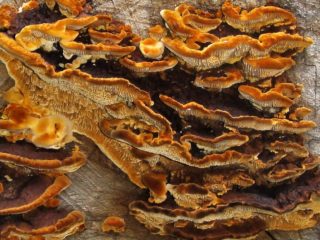Content
Gleophyllum oblongata is one of the representatives of tinder fungi of the Gleophyllaceae family. Despite the fact that it grows everywhere, it is extremely rare. Therefore, in many countries it is listed in the Red Book. The official name of the species is Gloeophyllum protractum.
What does Gleophyllum oblongata look like?
Gleophyllum oblong, like many other polypores, has a non-standard structure of the fruiting body. It consists only of an oblong, flat and narrow cap, but sometimes triangular-shaped specimens are found. The fruit body is leathery in structure, but bends well. On the surface you can see tubercles and concentric zones of different sizes. The cap has a characteristic metallic sheen, without pubescence. The mushroom grows 10-12 cm in length and 1.5-3 cm in width.
The color of Gleophyllum oblong varies from yellow-brown to dirty ocher. The surface may crack when the mushroom ripens. The edge of the cap is lobed, slightly wavy. In color it can be significantly darker than the main tone.
The hymenophore of Gleophyllum oblongata is tubular. The pores are elongated or round with thick walls. Their length reaches 1 cm. Young specimens of hymenophores have an ocher hue; when lightly pressed, it darkens. Subsequently, its color changes to reddish-brown. The spores are cylindrical, flattened at the base and pointed on the other side, colorless. Their size is 8-11 (12) x 3-4 (4.5) microns.
When broken open, flexible, slightly fibrous flesh can be seen. Its thickness varies between 2-5 mm, and the color is rusty-brown and odorless.

Gleophyllum oblongata is an annual mushroom, but sometimes it can overwinter
Where and how does it grow
This species settles on stumps and dead wood of coniferous trees, preferring trunks without bark. As an exception, it can be found on oak or poplar. It loves well-lit clearings, and often settles in clearings and forest areas damaged by fire, and is also found near human habitation.
This mushroom grows mainly solitarily. In Russia, it can be found in Karelia, Siberia and the Far East. Single finds were also recorded in the Leningrad region.
It is also found in:
- North America;
- Finland;
- Norway;
- Sweden;
- Mongolia.
Is the mushroom edible or not?
This mushroom is considered inedible.It is prohibited to eat it in fresh or processed form.
Doubles and their differences
In appearance, Gleophyllum oblongata can be confused with other mushrooms. Therefore, in order to be able to distinguish doubles, you need to know their characteristic features.
Gleophyllum logum. Its distinctive feature is the soft surface of the cap and the smaller pores of the hymenophore. The double is also inedible. The fruiting body has a prostrate, sessile shape. In addition, individual specimens often grow together. There is an edge on the surface. Color – brown with admixtures of brown or gray tint. Found on different continents. The lifespan of log gleophyllum is 2-3 years. The official name is Gloeophyllum trabeum.

Log gleophyllum poses a danger to wooden buildings
Gleophyllum fir. This species has a sessile, outstretched cap of brown or dark brown color. At the initial stage of growth, its surface is velvety. At the break you can see fibrous pulp of a reddish hue. This species causes gray rot, which eventually covers the entire tree. It can also settle on treated wood. The size of the mushroom does not exceed 6-8 cm in width and 1 cm in thickness. This lookalike is also inedible. Its official name is Gloeophyllum abietinum.

Gleophyllum fir prefers to settle on coniferous trees
Conclusion
Due to its inedibility, Gleophyllum oblong is not of interest to mushroom pickers. But mycologists do not ignore these fruits, since their properties have not been fully studied. Therefore, research in this area continues.








